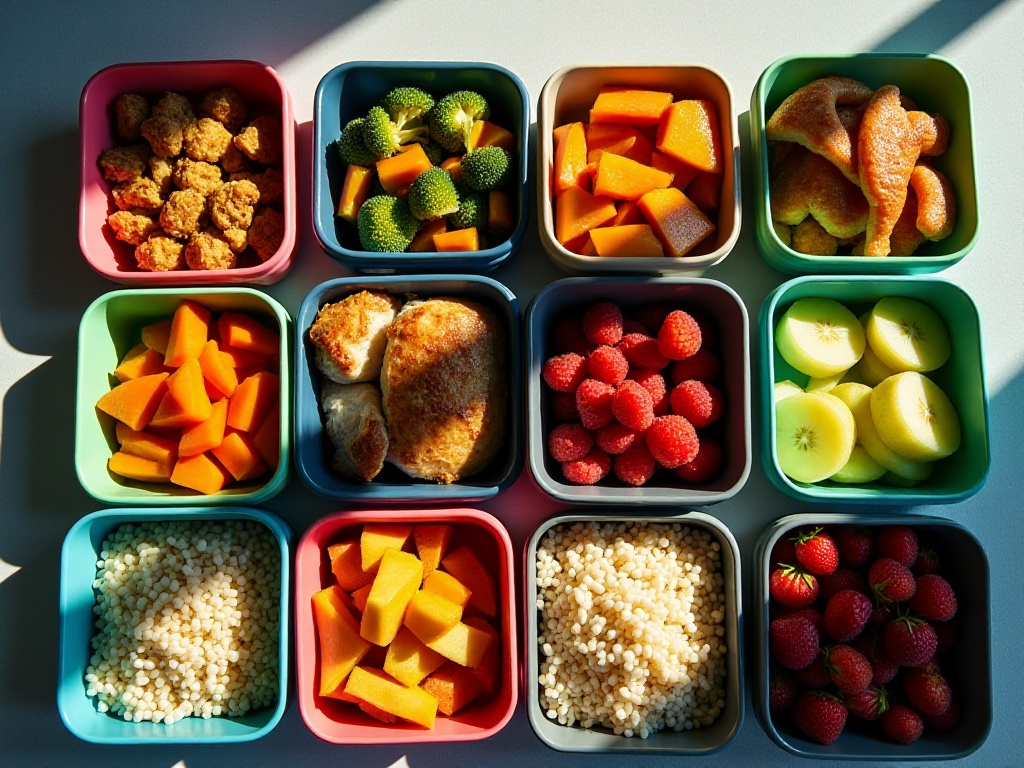
Introduction
Every morning when I wake up and check social media, I see lots of food photos, but we still struggle with the age-old question of "what to eat today." As a nutritionist, I deeply understand this struggle. For the past 3 years, I've been researching how to make healthy eating simple and practical, making it manageable even for busy young people. After continuous exploration and practice, I finally found a healthy eating plan suitable for urban dwellers. Today, I'll share my complete personal insights to help you easily solve your dining dilemmas.
Choosing the Right Staple Foods
I remember when I first started changing my diet, biting into whole wheat bread for the first time, that rough texture made me question everything. Are whole grains really that magical? Why must we eat these "strange-tasting" foods? With these questions in mind, I researched numerous nutrition studies and discovered that whole grains' nutritional value far exceeds refined grains.
Whole grains retain complete bran and germ, rich in B vitamins, vitamin E, minerals, and dietary fiber. Recent studies show that people who consume adequate whole grains daily not only reduce their cardiovascular disease risk by over 30% but also have more energy and better concentration. Now I truly understand why ancient people said, "Appreciate every grain of rice."
So, how do you learn to love whole grains? My secret is "mixed transition." For example, you can start with 20% brown rice and 80% white rice, then gradually adjust the ratio. That's how I started, and now I'm completely used to whole grains' texture and find refined grains tasteless. Honestly, even I find this transformation incredible.
For breakfast, I now basically have whole wheat toast with oatmeal. Choose whole wheat toast with over 70% whole grain content, paired with homemade fruit oatmeal - it's not only delicious but keeps you energized all day. Many colleagues see my breakfast and say, "Healthy food can be this tasty!"
Fruit and Vegetable Combinations
When it comes to fruits and vegetables, many people find them troublesome: unsure how to store them, buying too much leads to spoilage, preparation takes too much time... I've experienced all these challenges. But through continuous exploration, I've found that making fruits and vegetables dietary staples isn't difficult at all with the right methods.
Let's start with fruits. I always keep cut fruit on my desk, like apple pieces, orange segments, or grapes. Seeing them makes you want to eat them - that's visual inducement. Psychological research shows that food visibility directly affects our eating choices. When healthy foods are visible, you naturally eat more of them.
As for vegetables, I especially recommend the "rainbow diet method." Simply put, try to eat vegetables of different colors each day: red tomatoes rich in lycopene, orange carrots full of carotene, green broccoli supplying folic acid and vitamin C, purple eggplants rich in anthocyanins... Different colored vegetables contain different nutrients, and by consuming diverse vegetables, we get comprehensive nutritional support.
I prepare a "vegetable rainbow chart" every week, recording which colored vegetables I eat each day. This not only ensures balanced nutrition but also motivates me to try new vegetable varieties. For example, I recently fell in love with purple cabbage - it's not only nutritious but looks beautiful in salads, perfect for social media photos.
To make vegetables more delicious, I've also studied many cooking techniques. For instance, broccoli is best boiled to maximize nutrient retention; carrots are suitable for stir-frying with olive oil because carotenoids need fats for better absorption. These tips help me enjoy delicious food while fully absorbing nutrients.
Protein and Fat
When mentioning protein and fat, many people's first reaction is "eat less." However, these two nutrients are actually very important for our bodies - the key is choosing the right ingredients and cooking methods.
I especially recommend salmon, which is rich in omega-3 fatty acids and particularly beneficial for brain health. Eating salmon 2-3 times weekly not only improves memory but also delays brain aging. I often make simple sashimi with salmon slices, paired with wasabi and soy sauce - it's the perfect work meal.
Besides fish, chicken breast is also a good protein source. Many think chicken breast is too dry, but it can be delicious with proper marination. My favorite method is marinating chicken breast with lemon juice, rosemary, and black pepper, then pan-frying with olive oil until golden brown - maintaining juiciness without excessive oil.
Speaking of oils, olive oil is definitely my first choice. It contains abundant monounsaturated fatty acids, beneficial for cardiovascular health and helps the body absorb fat-soluble vitamins. I keep extra virgin olive oil for cold dishes and regular olive oil for cooking. This ensures nutrition while making food more delicious.
Soy products are also important sources of quality protein. I particularly enjoy making tofu salad, adding corn, cucumber, and carrots, topped with sesame dressing - both delicious and nutritious. Sometimes when I work late and don't have time to cook, a bowl of soy milk with whole wheat bread makes a decent dinner.
Eating Habits
Good eating habits are more important than what you eat specifically. I've experienced this deeply. I used to eat while watching shows, often overeating without realizing it. Later, I started practicing "mindful eating" and gradually discovered food's true flavors.
Breakfast is absolutely the most important meal of the day. Many young people habitually sleep until the last minute, then hastily deal with breakfast or skip it entirely. However, research shows that people who eat breakfast regularly not only control weight more easily but also have higher work efficiency. Now I reserve half an hour for breakfast every day, and it makes a noticeable difference in my overall condition.
Focused eating is also particularly important. I now strictly follow the "20-minute rule" - spending at least 20 minutes on each meal, chewing slowly. This not only allows full appreciation of food flavors but also gives the brain enough time to receive satiety signals. It might feel extremely slow at first, but after getting used to it, you'll find this eating style helps you enjoy food more and control portions better.
Regular timing and portions are also important principles of healthy eating. I adjust my diet according to daily activity levels - for example, eating more carbohydrates on exercise days and controlling intake on sedentary office days. This flexible eating approach helps me maintain my figure without suffering from hunger.
Snack Management
Honestly, when first changing dietary habits, snacks were the hardest to control. Wanting chips while watching shows, craving chocolate while working overtime - these scenarios easily trigger snack cravings. But after years of practice, I finally found an effective snack management method.
First is snack selection. I only keep healthy snacks at home, like sugar-free popcorn, mixed nuts, and dried fruits. This way, even if I can't resist snacking, I'm eating relatively healthy foods. I especially recommend homemade popcorn - pop corn kernels in the microwave without oil or salt, add a little cinnamon powder, and it's both fragrant and healthy.
Nuts are another favorite of mine. Eating a small handful of mixed nuts daily not only supplements vitamin E and minerals but also provides satiety. But portion control is important as nuts are quite caloric. I pre-package daily portions in small bags to prevent unconscious overeating.
Dried fruits are also a good choice, but choose ones without added sugar. I particularly like dried blueberries and dried figs - naturally sweet and rich in dietary fiber. However, dried fruits have much higher calories than fresh fruits, so limit portions to a small handful.
Snack storage location is also important. I keep all snacks in a cabinet that's not easily accessible, rather than within arm's reach. This way, every time I want snacks, I need to make an effort to get them, allowing time to think: do I really need this snack?
Interestingly, I found that hiding snacks led to eating much less unconsciously. This has scientific basis - research shows that snack visibility directly affects intake, and keeping snacks out of sight can reduce consumption by an average of 125 calories daily.
I've also developed a habit: drinking water first when wanting snacks. Often we mistake thirst for hunger, and after drinking water, the snack craving might disappear. If I still really want to eat, I'll have a fruit first, and only if I'm still hungry after that will I get some healthy snacks.
Life Details
Success in healthy eating often lies in small life details. For example, regarding beverage choices, I used to love milk tea and sodas but now completely switched to sugar-free sparkling water. If it feels too plain, add a slice of lemon or some mint leaves - it's both refreshing and energizing.
I especially recommend homemade fruit-infused water. Putting various fruit slices in room temperature water is not only attractive but very refreshing. My favorite combination is lemon slices with blueberries - providing both vitamin C and antioxidants, plus it looks great in photos.
Ingredient storage is also a science. I've developed a fixed shopping and storage routine: shopping once every weekend, immediately processing everything upon returning home. Leafy greens are washed clean, dried, and packed in storage bags; fruits are checked for damage and properly divided into different containers; meat is portioned for each meal, wrapped in plastic wrap, and refrigerated.
This storage method seems troublesome but actually saves lots of time. Whatever you want to eat is ready to use, without washing and dividing each time. Plus, ingredients last longer, greatly reducing waste.
I also keep frozen vegetables and fruits in my freezer. Peas, corn kernels, and broccoli can all be frozen, ready for a healthy meal in emergencies. Fruits can also be frozen - blueberries and strawberries are especially suitable, blend them directly into smoothies, healthier and tastier than store-bought ones.
Tableware choice is also important. I deliberately bought smaller-sized dishes, so even when full, portions aren't too large. Psychological research shows that using smaller tableware effectively controls portion size without affecting satiety.
Additionally, I record daily food intake. Not to count calories, but to understand my eating patterns. Through recording, I discovered I tend to eat sweets when stressed, and knowing this, I can prepare healthy alternatives in advance.
Final Words
After saying all this, the core of healthy eating is: making health a lifestyle, not a burden. Everyone's physical condition and life habits are different; the key is finding what works for you.
These suggestions have all been tested through practice. They've helped me maintain healthy eating habits despite busy work, and I hope they can provide some inspiration for those seeking a healthy lifestyle.
Change doesn't need to happen overnight - start with the simplest things, like spending 10 more minutes on breakfast tomorrow, or buying some fresh fruit on your way home. Step by step, with persistence, you'll achieve unexpected changes.
After all, healthy eating is the best gift you can give yourself - let's start this delicious journey together!
Next
Smart People's Nutrition Management Tips for Effortless Health and Fitness
A comprehensive guide to healthy eating and nutrition, covering balanced diet composition, healthy eating habits, and practical tips. Detailed information on choosing carbohydrates, proteins, healthy fats, and strategies for diverse fruit and vegetable intake
Done Being a Nutrition Novice? This Comprehensive Nutrition Guide Will Help You Eat Scientifically Starting Today
A comprehensive guide exploring core principles of balanced nutrition and healthy eating, including nutritional optimization advice, scientific dietary methods, and practical meal management tips to help readers establish healthy eating habits
A Nutritionist Tells You: This is How to Eat Healthy Without Too Much Hassle - I've Been Practicing for 3 Years
A comprehensive guide to healthy eating and nutrition improvement, covering dietary principles, habit formation, and practical tips on whole grain selection, fruit and vegetable combinations, and protein intake for a balanced diet
Next

Smart People's Nutrition Management Tips for Effortless Health and Fitness
A comprehensive guide to healthy eating and nutrition, covering balanced diet composition, healthy eating habits, and practical tips. Detailed information on choosing carbohydrates, proteins, healthy fats, and strategies for diverse fruit and vegetable intake

Done Being a Nutrition Novice? This Comprehensive Nutrition Guide Will Help You Eat Scientifically Starting Today
A comprehensive guide exploring core principles of balanced nutrition and healthy eating, including nutritional optimization advice, scientific dietary methods, and practical meal management tips to help readers establish healthy eating habits

A Nutritionist Tells You: This is How to Eat Healthy Without Too Much Hassle - I've Been Practicing for 3 Years
A comprehensive guide to healthy eating and nutrition improvement, covering dietary principles, habit formation, and practical tips on whole grain selection, fruit and vegetable combinations, and protein intake for a balanced diet
